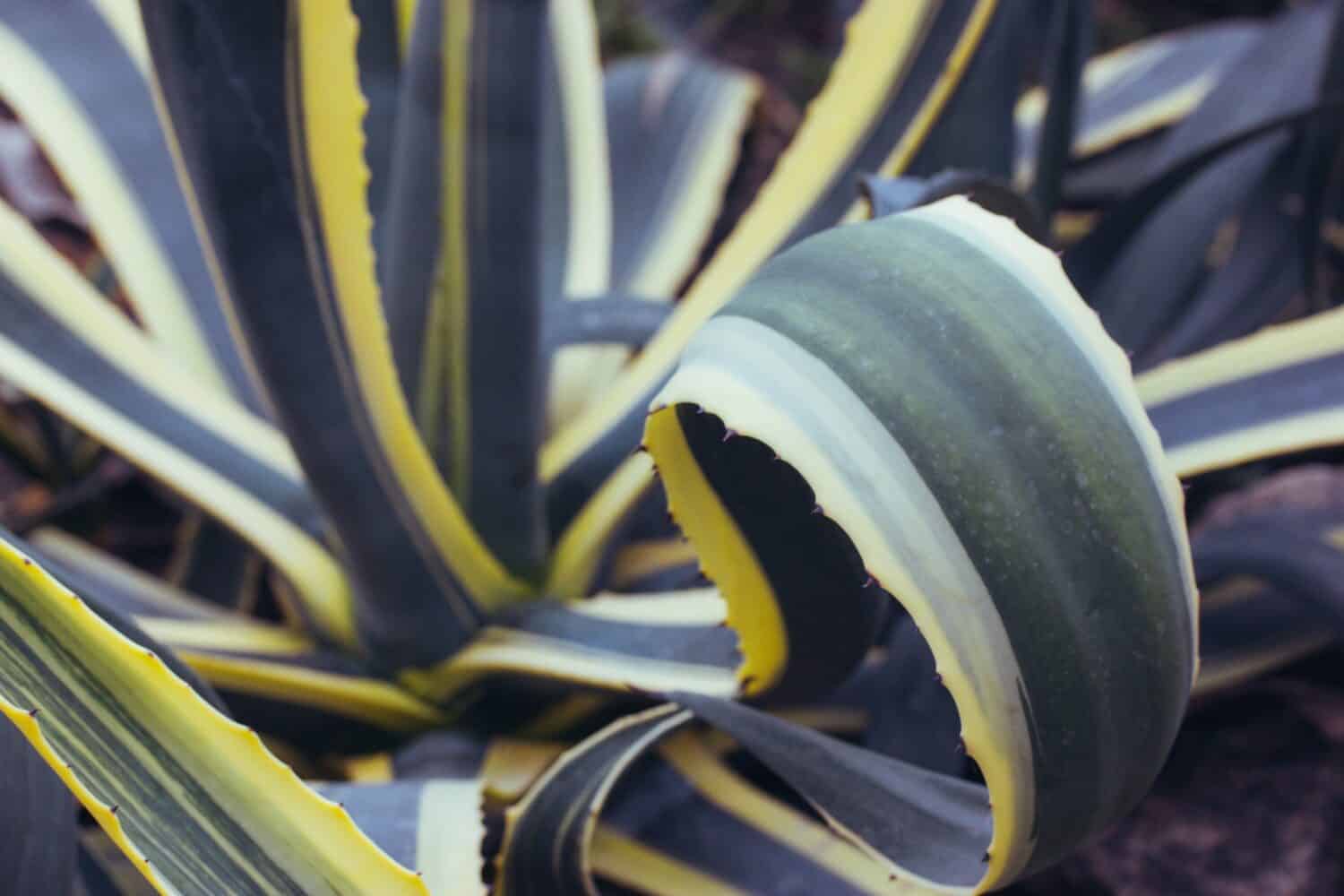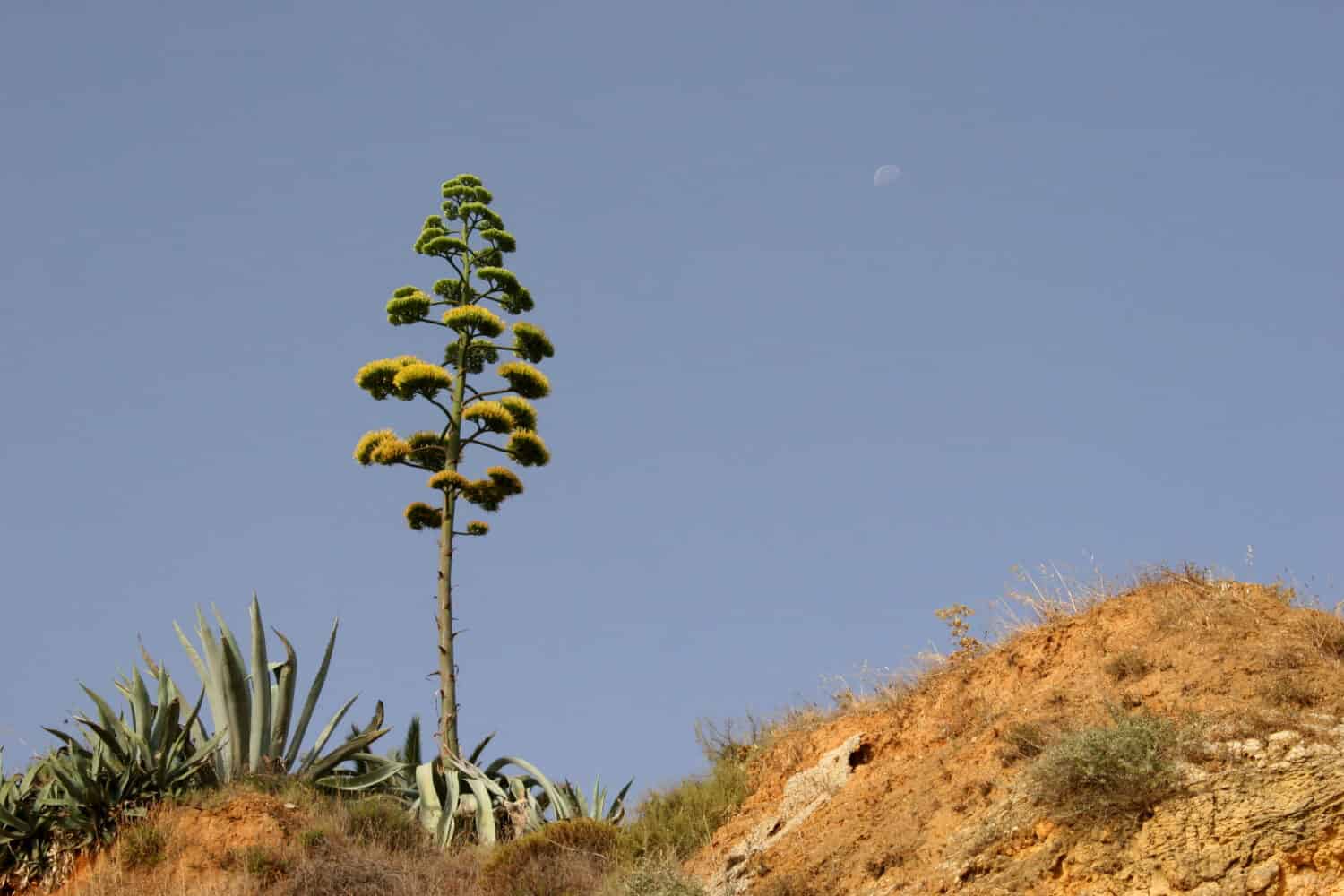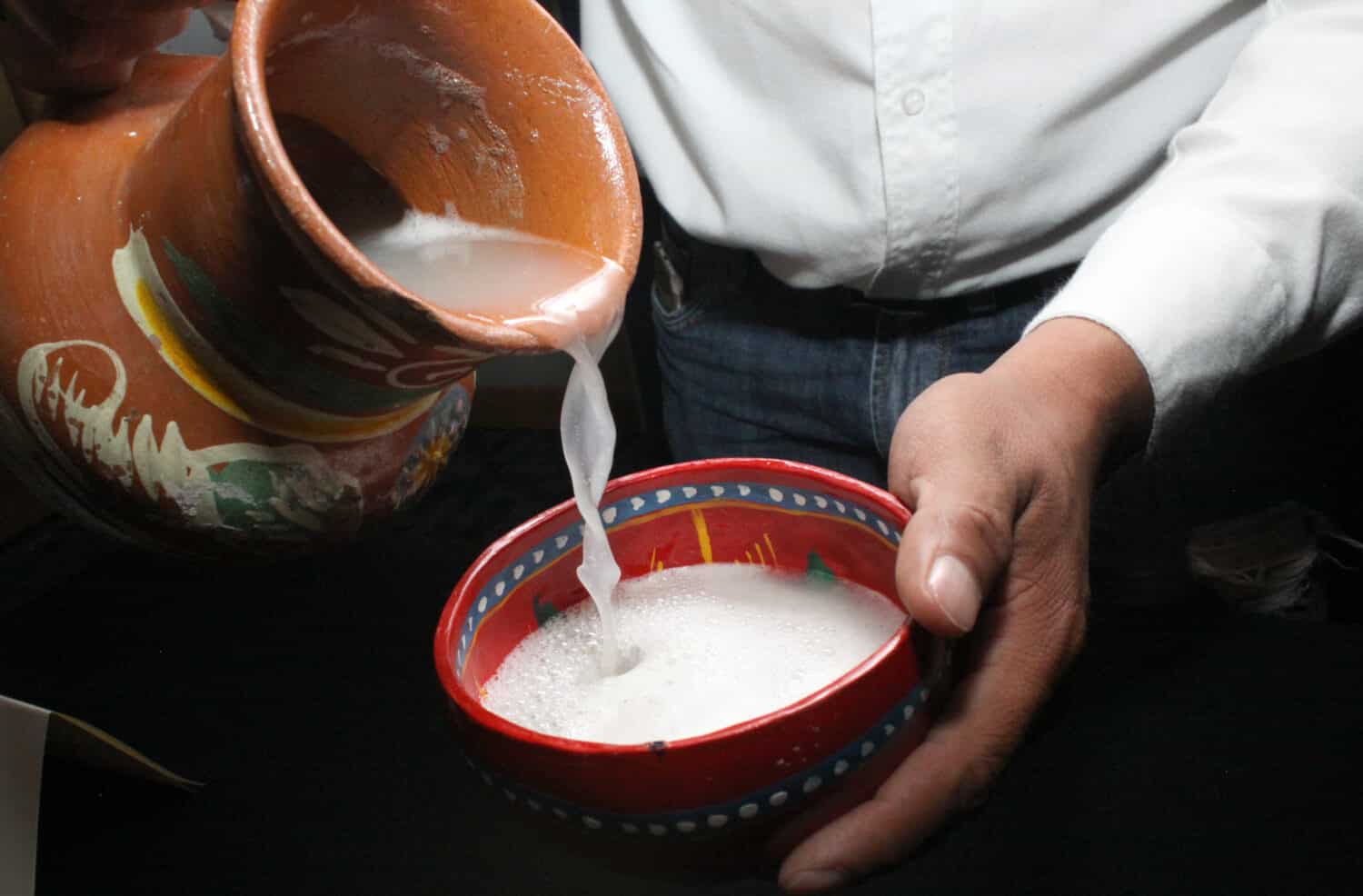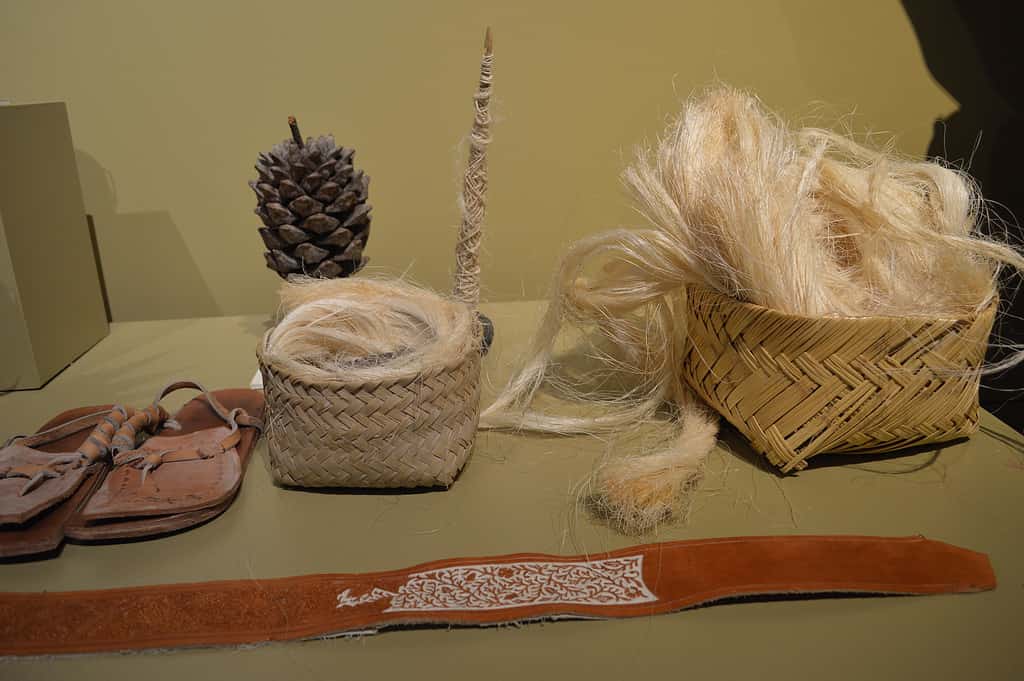In the captivating world of flora, there exists a mesmerizing plant that defies expectations. This is a remarkable plant that only blooms once every 30 years! it leaves botanists and nature enthusiasts in awe. Get ready to be enchanted by this extraordinary specimen!
Plant That Blooms Only Once Every 30 Years—Century Plant

This enormous plant blooms only once every 30 years.
©Elena Kirey/Shutterstock.com
The century plant, or Agave americana, is a stunning succulent that is native to the desert regions of the United States, Mexico, and Central America. It is a hardy plant that is capable of surviving in a wide range of temperatures, from -4°F to over 100°F, and can survive in both dry and humid climates.
The century plant has a signature appearance that makes it easily recognizable. Its leaves are long and spiny, with a grayish-green color. The leaves grow in a rosette shape, sometimes reaching up to 6 feet in diameter. The plant also features a long, sturdy stem that can grow up to 26 feet tall and a large flower bud at the top of the stem.
The century plant’s flowers are yellow-green in color and have a unique, bell-shaped structure. The flowers are often covered in a sweet-smelling, sticky nectar that is attractive to bees and other pollinators. The buds are capable of producing up to 100,000 flowers, making it a beautiful sight to behold.
The Century Plant is an impressive and hardy species that has adapted to thrive in a wide variety of climates. Its unique physical features, large flowers, bloom once every 30 years. Some plants may bloom after only 10 years.
Types of Century Plants

Some cultivars of A. americana are variegated or striped.
©Al More/Shutterstock.com
The century plant is in the asparagus family. When the flower stalk first appears, it looks just like a thick and robust spear of asparagus. After the stalk is finished growing, a brilliant flower head forms on the very top. It has yellow pods and spreads through pups or offsets. There are two subspecies of A. americana and quite a few beautiful cultivars.
- ‘Variegata’ is a century plant that blooms once every 30 years and has green leaves with white edges.
- ‘Striata’ is a cultivar with both yellow and white stripes along each leaf.
- ‘Mediopicta Aurea’ has a central yellow stripe that is thick and bright.
- ‘Mediopicta Alba’ is a century plant that blooms once every 30 years and has a thick white central band down each leaf.
- Marginata’ is a cultivar with yellow edges along each leaf edge.
- Mediopicta’ is a century plant that blooms once every 30 years and has a cream-colored middle stripe, green edges, and a very tall stalk.
Landscaping With a Plant That Blooms Once Every 30 Years

It may be a plant that blooms only once every 30 years, but the stately flowers can be up to 26 feet tall.
©Natalka De/Shutterstock.com
A. americana, also known as the “Amazing Plant That Only Blooms Once Every 30 Years,” is not only prized for its unique blooming pattern but also cultivated as an ornamental plant due to its stunning mature form. With its large and dramatic appearance, it has become a favorite in modernist gardens, specifically xeriscapes that can withstand drought conditions and desert-style cactus gardens.
The popularity of the century plant extends to hot climates and areas prone to drought, where its ability to thrive with minimal water makes it a valuable addition to landscapes.
However, the century plants’ appeal is not limited solely to arid environments. It has also found favor in unexpected locations, such as hot beach gardens in Florida and seaside areas of the Southeastern United States. Here, too, this amazing plant stands out as a favored choice for landscaping projects.
How to Cultivate an Outdoor Century Plant

A. Americana is hardy in Zones 8-11.
©G Allen Penton/Shutterstock.com
Century plants are a beautiful and popular species of agave that can be grown outdoors. To cultivate an outdoor century plant, you should follow these steps:
- Choose an appropriate location. Century plants prefer full sun and well-draining soil. A minimum of 8 hours of direct sunlight is best.
- A. americana is perennial in USDA Hardiness Zones 8 to 11.
- Plant your century plant in the ground or in a container.
- Water your century plant deeply, but not often. Make sure to avoid overwatering, as excess moisture can cause root rot.
- Fertilize your century plant every 30 days during the spring and summer
- to encourage healthy growth.
- Prune away dead or dying leaves to keep your plant looking its best.
- Monitor your plant for signs of disease or insect infestations. Treat any issues promptly to make sure your plant stays healthy.
Can You Grow a Century Plant as a Houseplant?
You can easily grow an American agave (century plant) indoors as a houseplant! Its light requirements range from direct sunlight to bright indirect light, and it only needs a little bit of water. It requires a winter resting period if it is growing indoors with temperatures around 50-54°F. Since most houses are warmer than this, plan to place your century plant on an unheated porch, basement, or garage for the winter so it can go fully dormant. Plant it in a sandy, porous soil mixture. Let the soil dry out between waterings, and be sure to give it a large pot every two years.
Beverage Made From a Plant That Blooms Once Every 30 Years

Pulque is a traditional drink that people in Mexico make from the century plant.
©Angel Malo/Shutterstock.com
Agave americana, a plant that only blooms every 30 years, was utilized in pre-Columbian Mexico for various purposes. If the stem was cut before flowering, a sweet liquid, known as aguamiel, could be collected from the center of the plant. People used this liquid to make an alcoholic beverage called pulque or octli, which was popular in pre-Columbian Mexico.
Agaves, also known as mezcales, are used by people in certain parts of Mexico to make a strong alcoholic beverage. Tequila, in particular, is made from the “blue agave” species (A. tequilana). There are various types of mezcal, some of which may be infused with the distinctively pungent mezcal worm.
Agaves are abundant in Latin America and are used in comparable methods. In Ecuador, a recipe similar to pulque is labeled guarango, which people further distill and turn into miske. Agave nectar is sold as a natural sugar alternative with a low glycemic index, mainly due to its significant fructose quantity.
Mezcal and tequila, even though they are made from agave plants, are different from pulque because of the way they obtain their sugar and are categorized as distilled beverages. With mezcal and tequila production, the sugars are obtained by heating the hearts of the plants in ovens instead of getting aguamiel from the cut stem of the plant. Therefore, if pulque were to be distilled, it would not be classified as mezcal but rather as a unique drink.
Century Plant Fibers
The leaves of A. americana, commonly known as the century plant, possess a remarkable attribute that has long fascinated botanists and craftsmen alike: they yield fibers called pita. These fibers are not only sturdy but also versatile in their applications.
One of the most notable uses of pita fibers is in the production of ropes. The strength and durability of these fibers make them ideal for creating robust materials that can withstand heavy loads or harsh environmental conditions. Whether it be securing cargo or constructing a durable shelter, pita fiber-based products have proven to be reliable companions throughout history.
People weave the fibers of A. americana into coarse cloth, mats, sacks, nets, and bags as well. They are very sturdy and last many years.
Century Plant in Art

Piteado is an artisan technique that people use to weave century plant fibers into lovely items.
In addition to their practical applications, pita fibers have also found their place in the realm of artistry. Piteado is a traditional leather embroidery technique extensively practiced in Mexico. It showcases the beauty and intricacy that can be achieved with these plant-based threads. By skillfully intertwining colorful pita fibers into intricate patterns on belts or saddles, artisans showcase their mastery.
It is worth noting that both pulque (a fermented alcoholic beverage) and pita fiber derived from A. americana played significant roles in shaping Mexico’s pre-Columbian economy. Pulque was not only consumed by ancient civilizations but also held cultural significance during religious ceremonies and festivities. Meanwhile, pita fiber served as a valuable commodity for making essential items such as rope, clothing, and even paper. It is no wonder, then, that the plant has been immortalized in art forms like piteado, which allows modern-day artisans to keep this ancient tradition alive.
See This Blooming Plant in Action Below:
Thank you for reading! Have some feedback for us? Contact the AZ Animals editorial team.







